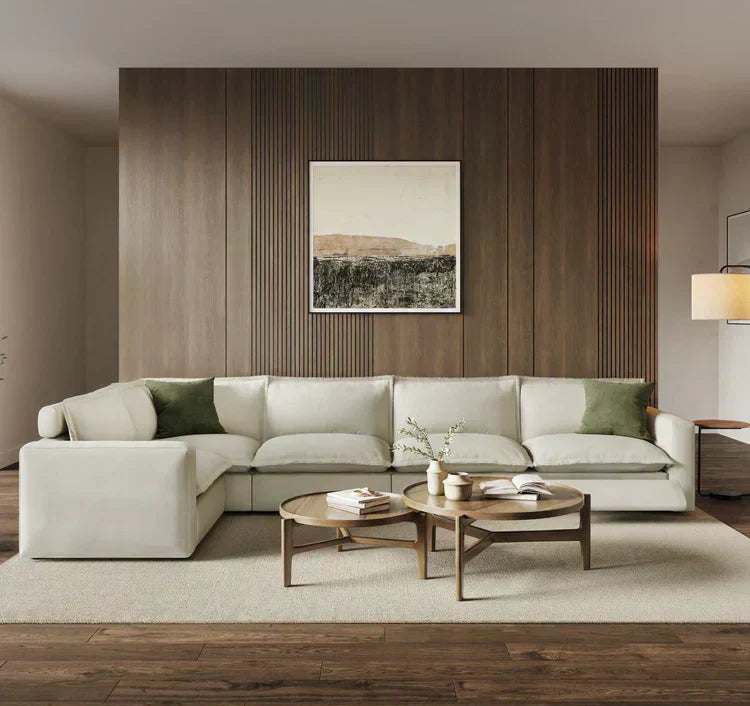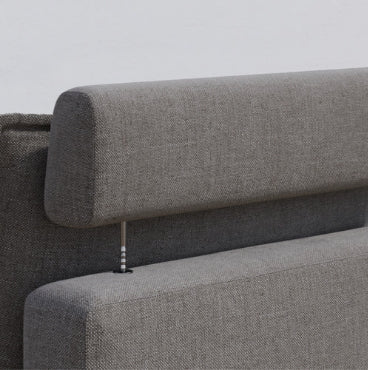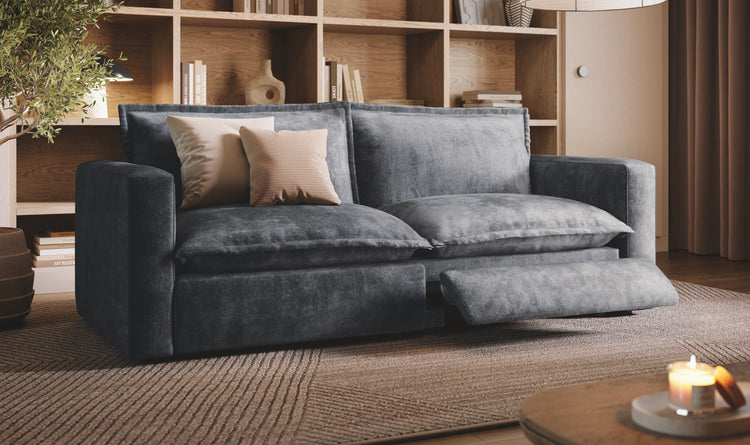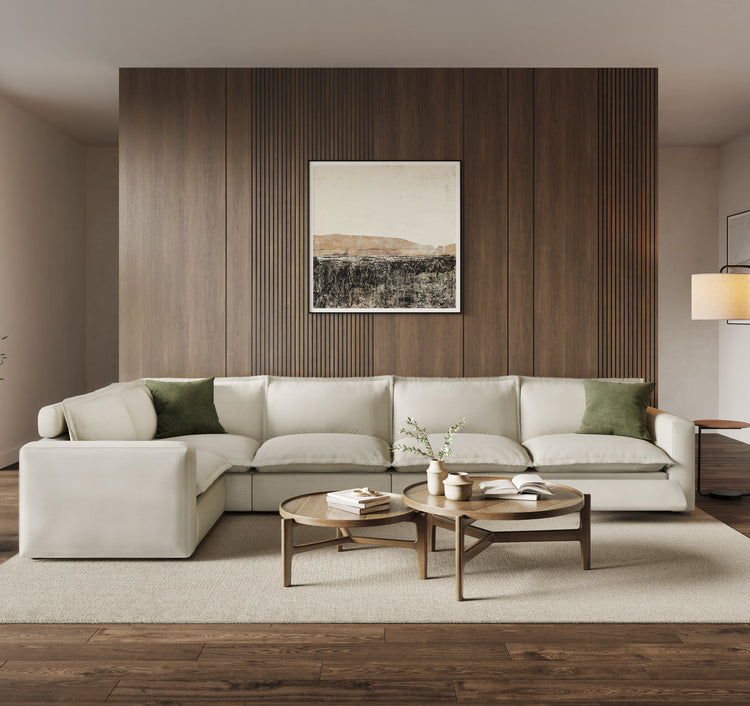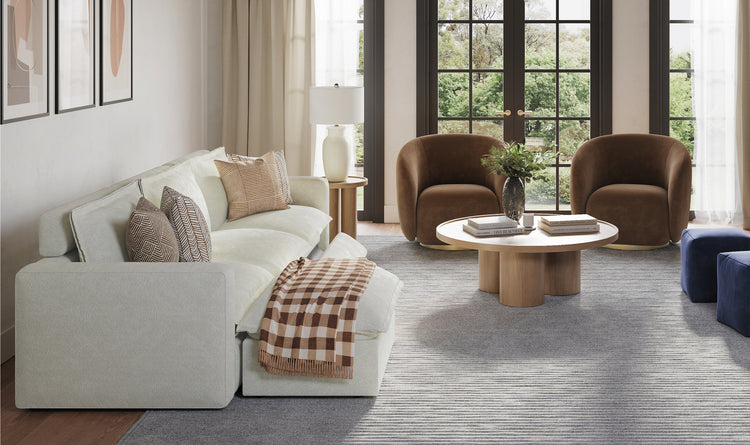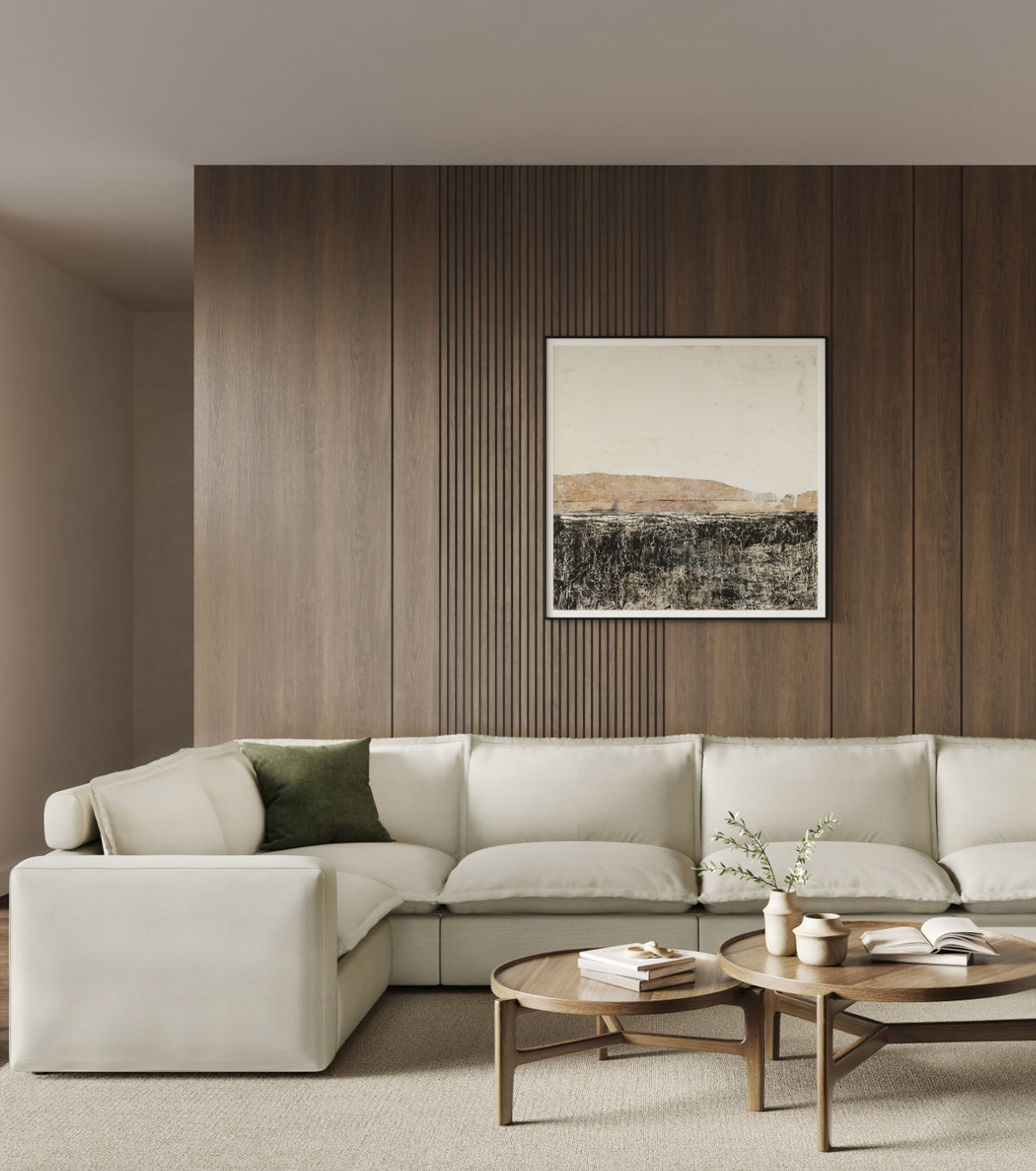Arranging furniture in your living room can feel overwhelming, especially when working with a statement piece like an L-shaped couch. Many homeowners struggle to position these versatile sectionals in a way that looks good and functions well for their space. L-shaped couches have become incredibly popular because they offer generous seating while adapting to different room sizes.
Whether you have a cozy apartment or a spacious home, your sectional can transform your living area when positioned thoughtfully. This article covers practical layout options for both small and large rooms, helping you create a comfortable, stylish space that works for your lifestyle.
Why Choose an L-shaped Couch?
L-shaped couches have become increasingly popular in home design for good reasons. These sectional sofas offer practical advantages that make them worth considering when furnishing your living space. Here's why an L-shaped couch might be the right choice for your home:
- More Seating in Less Space: L-shaped couches provide substantially more seating space than standard sofas without the use of numerous pieces of furniture. A single L-shaped sectional can comfortably fit 5-7 people, making it suitable for families or individuals who have numerous guests. The space-saving design eliminates the use of additional chairs or loveseats that take up additional floor space.
- Works in Any Size Room: Despite common misconceptions, L-shaped couches aren't just for large spaces. In smaller rooms, they optimize corner spaces and open the center of the room for easy passage. In larger living rooms, they define distinct areas and prevent the wastefulness or isolation of one large empty room.
- Adaptable to Different Layouts: Many L-shaped couches come as modular units that can be reconfigured as needed. This allows you to effortlessly switch your setup whenever you redesign your room to get maximum lounging or move to a different location. Some even allow you to reverse the orientation of the chaise lounge from left to right, adapting to different room arrangements.
- Perfect for Open Floor Plans: In open-concept homes, L-shaped couches naturally define the living area without requiring walls or dividers. They establish a visual separation between dining and living spaces without sacrificing the openness that makes open floor plans desirable. This functionally organizes your space without stripping an open plan of its airy quality.
4 Key Considerations Before Arranging an L-Shaped Couch
Before moving your L-shaped couch into position, taking time to plan will save you effort and frustration.
1. Measure Your Room and Couch First
Proper furniture placement requires correct measurements. Figuring out the ideal couch dimensions for your space is a critical first step. Measure your entire room's width and length, where doors, windows, and architectural features are. Measure your L-shape sofa, depth, and width of both parts. Maintain a minimum of 30-36 inches in front of and about your couch to facilitate movement.
Proper furniture placement requires correct measurements. Measure your entire room's width and length, where doors, windows, and architectural features are. Measure your L-shape sofa, depth, and width of both parts. Maintain a minimum of 30-36 inches in front of and about your couch to facilitate movement.
2. Pick the Right Left or Right Layout
L-shape couches come in left-hand or right-hand versions, i.e., which side the longer section extends when you're facing the couch. This matters to your room layout. To determine which one will be best, consider your room entrances, existing furniture, and how you plan to use the space. The wrong configuration can block traffic or create unappealing arrangements with other furniture pieces.

3. Point Your Couch at What Matters Most
Place your L-shaped couch within the context of your room's central focal point. Typical focal points are televisions, fireplaces, large windows with a view, or architectural elements. Ideally, the central seating area needs to be oriented toward this focal point for maximum viewing or interaction. In cases of multiple focal points within a room, make the central seating area face the focal point you use most often.
4. Keep Walkways Open
Consider how people move through your living space. Your couch position should never restrict natural movement through the room. Note doorways, hallways, and transitions to other areas of your home. Leave enough clearance for people to move around without needing to squeeze between furniture or bump into the couch corners. This is particularly important in high-traffic homes or homes with children, elderly, or people with mobility concerns.
How Can You Arrange an L-shaped Couch in a Small Living Room?
Once you've measured your space and chosen the right configuration, it's time to place your L-shaped couch. Small rooms can actually work well with sectionals when positioned correctly. Here are three simple layouts that make the most of limited space while keeping your room comfortable and functional.
Put Your Couch in a Corner to Save Space
In small rooms, corners are often dead space. Putting your L-shaped sofa in a corner takes advantage of the typically wasted space and opens up the middle of the room. This will create a natural conversation space without obstructing open paths through the room. Pair your sectional with a small coffee table or slipper Chairs that can be moved out of the way when needed. Round or oval-shaped tables are ideal because they eliminate corners that might inhibit mobility in small spaces.
Place Your Couch Near Windows for Better Light
Placing your L-shape couch against a window wall serves many functions in a small space. The design takes advantage of sunlight, making the room look brighter and larger. The couch won't obstruct the light source, and anyone on it can enjoy the view outdoors. For this setup, leave other things uncluttered—use light or neutral tones for accessories and restrict decorative objects to avoid visual overload. Put the shorter side of the sectional away from the window to ensure an open sensation.
Create a Conversation Circle With Your Couch
Convert your living room into a snug gathering room by creating a half-circle conversation circle. Position your L-shaped sectional as the center, and complete the circle with a small armchair, pouf, or accent chair positioned directly opposite the sectional's short side. This placement invites face-to-face conversation with ease while taking full advantage of limited square space. Place furniture pieces in proportion to the room size—massive pieces will make the room congested. A small side table between the additional seating and the sofa offers functionality without compromising much room.
How Can You Arrange an L-shaped Couch in a Large Living Room?
Large living rooms offer creative opportunities for L-shaped couch placements beyond straightforward wall placements. With greater square footage to work with, you have the versatility to position your sectional in creative designs that define your room and offer improved functionality.
Place Your Couch in the Middle of the Room
Large rooms allow you to float your L-shaped sofa off the walls, creating a dramatic centerpiece in the center of your room. Position the sectional back to a walkway or entrance rather than against a wall. The dramatic positioning creates instant living space while allowing for movement around all sides. Balance the arrangement with the addition of complementary seating facing the open end—a pair of matching armchairs, an elegant bench, or even a smaller loveseat works. An oversized coffee table anchors the cluster and a large area rug underneath ties all furniture together in a unified seating area.
Use Your Couch to Split Up Spaces
In open-plan spaces, an L-shaped sectional is an ideal room divider without blocking light or sightlines. Position your sectional so the back of it becomes a natural dividing line between your living area and dining space or kitchen. It creates distinct areas without losing the open feel. For a harmonious look between spaces, use similar color palettes or complementing colors in both spaces. Put in a console table behind the sofa to serve as a smooth transition point, perfect for holding together decor that ties both areas together or introducing surface space to the dining area.
Make Room for Family Time
Design the ultimate conversation pit by situating your L-shaped sofa as one corner of a square. Put in the sectional as the base and top of the square with other units of seating turned toward the open ends. This arrangement is especially fantastic for game nights with the family or having people over because everyone can just see and talk to each other. A large coffee table or ottoman in the center serves as a useful space and a focal point. For maximum flexibility, include movable pieces like poufs or side chairs that can be easily rearranged when hosting larger groups or when an individual wants to sit with their back to the TV.
How to Style Your L-Shaped Couch for Maximum Impact
While finding the perfect placement for your L-shaped couch is essential, the styling choices you make afterward truly bring your living room together. The right accessories and complementary pieces can enhance your sectional's presence, whether it's nestled in a cozy corner or commanding the center of a spacious room.
Get the Right Size Rug
A properly sized area rug anchors your L-shaped sectional and defines your seating area. To achieve the most proportionate look, choose a rug that's big enough to accommodate all front legs of your couch and any other furniture pieces. In a small room, ensure the rug extends at least 6-8 inches on all sides past your sectional. For larger rooms, select a large rug that unifies the entire seating arrangement. Position the rug under your coffee table in the middle, with equal margins between the edges of the rug and the room's edges for a balanced look.
Add Pillows and Blankets
L-shaped sofas provide the ideal base for those showy accessories that add color, texture, and personality. Start with a foundation of plain pillows in various sizes, then add 2-3 accent pillows in brighter shades or patterns that complement the color palette of your room. Mix textures for visual interest by pairing up various materials like velvet, linen, or woven textiles. Add a coordinating throw blanket tossed over the back or arm of the sectional—hang it loosely folded rather than precisely straight for an inviting, lived-in feel.

Pick the Best Coffee Table Shape
The ideal coffee table completes your L-shaped sofa arrangement and provides a desirable function. In tiny spaces or sectionals that have chaise ends, oval or circular tables eliminate severe corners and facilitate movement around the seating. In expansive rooms, square or rectangular tables better fill the area defined by the L-shape and provide ample surface area. Leave around 18 inches of room between the table and seating for comfortable access. Consider height as well—your couch cushions and your coffee table should be the same height or 1-2 inches lower for optimal proportion and use.
Common Mistakes to Avoid When Placing Your L-Shaped Couch
Even with the ideal sectional and accessories, certain arrangement errors can make your living room less functional and beautiful.
Mistake 1: Buying Furniture That's Too Big
An oversized L-shaped sectional can make your space feel cramped and imbalanced. Measure your area prior to purchasing and have at least 30 inches available for walkways. In smaller rooms, select a small sectional with elevated legs to produce a feeling of space. Ensure your coffee tables, side tables, and additional seating are proportional to the size of your room and sectional.
Mistake 2: Blocking Walking Paths
Even properly sized sectionals can disrupt room flow when carelessly placed. Avoid placing your L-shaped couch in a doorway, window, or natural path through the room. Create clear routes to all doors and exits within your design. Open floor plans require at least a 3-foot distance between sectionals and dinner areas to prevent them from narrowing overall use.
Mistake 3: Ignoring Room Focal Points
Your L-shaped sofa must complement your room's main elements, not struggle against them. Place your sectional to face fireplaces, large windows, or TV spaces. Steer clear of configurations in which visitors need to turn ungracefully to view the TV or join discussions. When your room features several focal points, give preference to the most significant one when placing your sectional. When prominent features are situated on various walls, utilize the L-shape to tackle both simultaneously.
Make Your L-Shaped Couch Work For You Today
Setting up your L-shaped couch doesn't have to be complicated. Just avoid three common mistakes: don't buy furniture that's too big for your space, keep walkways clear, and position your couch facing important features like your TV or fireplace. Start by measuring your room and thinking about how you naturally move through it. Don't worry if you need to rearrange things later—most people find their perfect setup after living with their couch for a few weeks.
